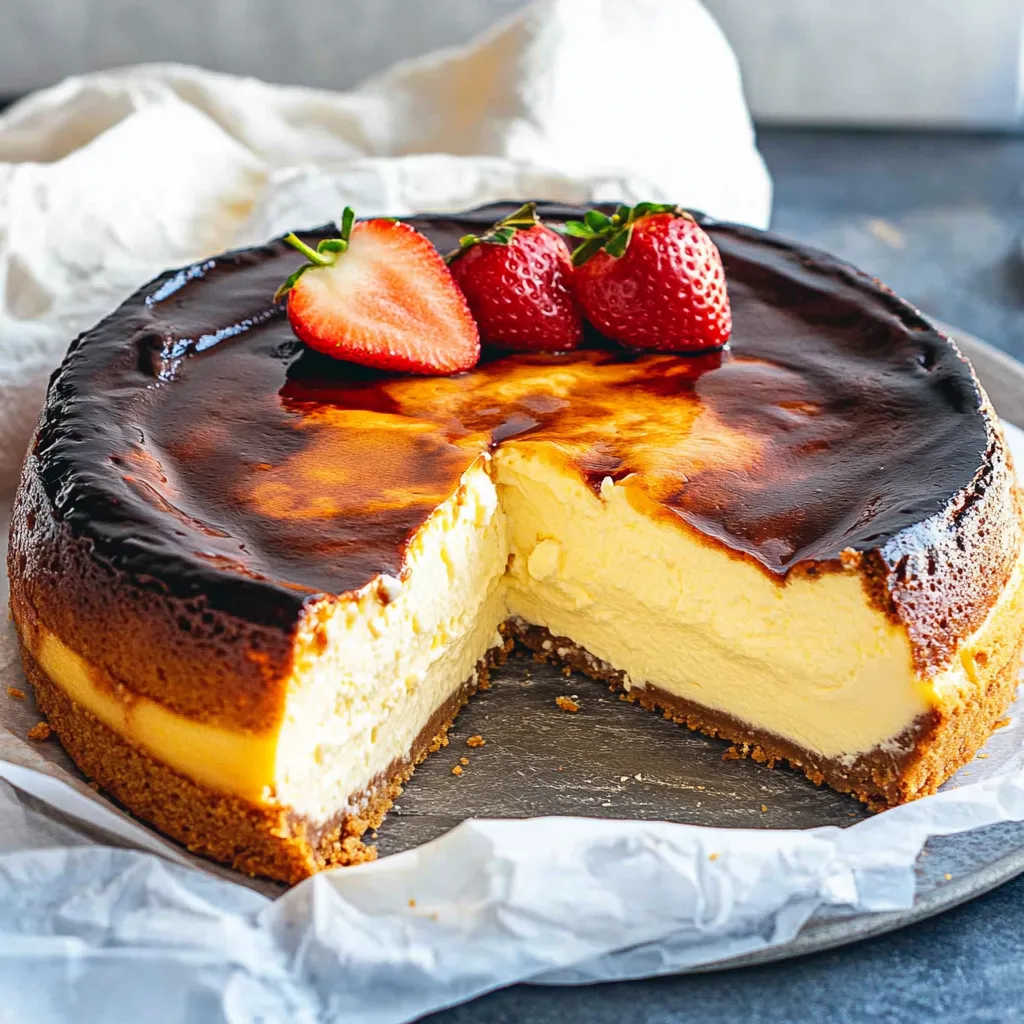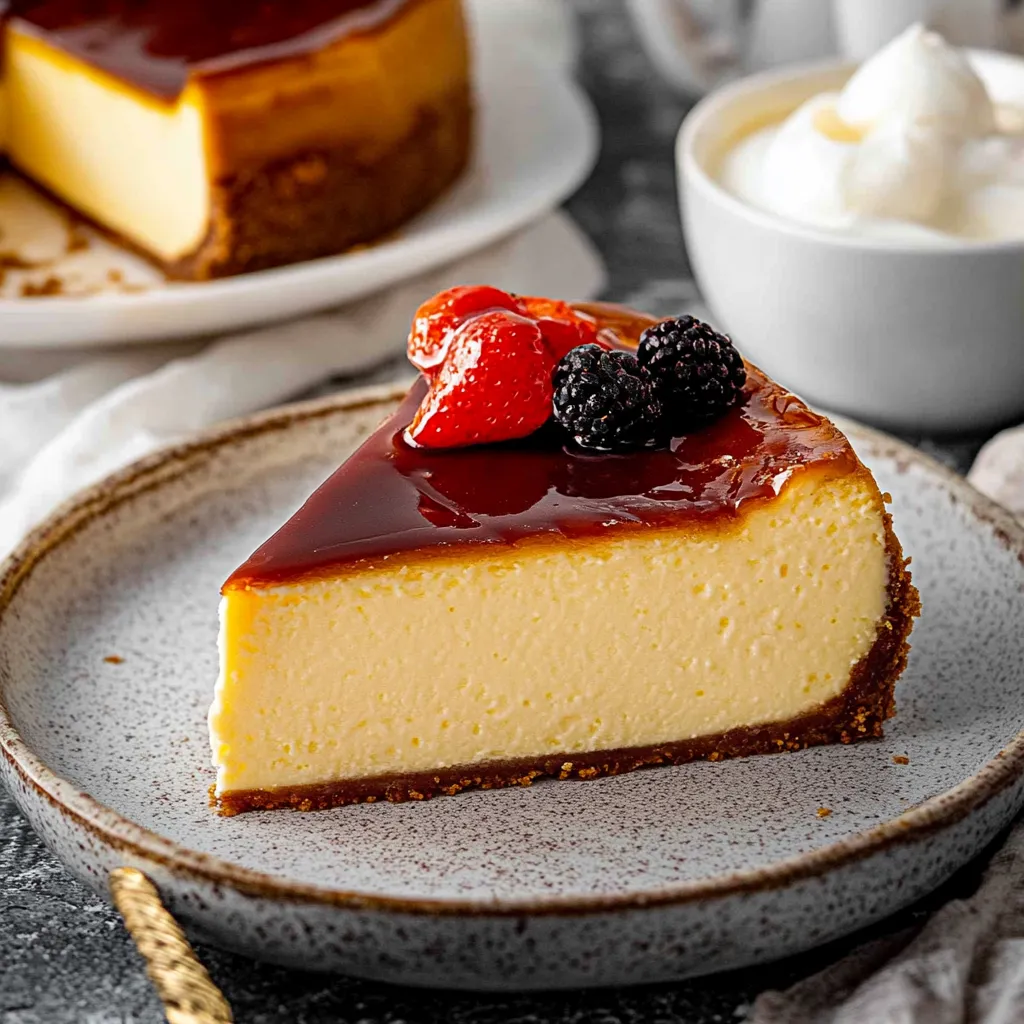 Bookmark
Bookmark
This decadent San Sebastian cheesecake transforms simple ingredients into a creamy, caramelized dessert that will transport you straight to the Basque Country. The burnt top and custardy center create a textural masterpiece that's surprisingly easy to achieve at home.
I discovered this recipe during a trip to Spain and have been perfecting it for years. My dinner guests always fall silent when taking their first bite the contrast between the caramelized top and creamy interior is truly something special.
Ingredients
- Cream cheese: 600 grams room temperature for the smoothest texture and to prevent lumps
- Granulated sugar: 200 grams provides just the right amount of sweetness and helps create the caramelized top
- Large eggs: 4 room temperature eggs incorporate more easily and create a better texture
- Heavy cream: 400 milliliters gives the cheesecake its signature silky texture
- All purpose flour: 25 grams just enough to provide structure without making it dense
- Salt: a pinch enhances the flavor and balances the sweetness
- Vanilla extract: 1 teaspoon optional but adds depth of flavor
Step-by-Step Instructions
- Prepare the Oven and Pan:
- Preheat your oven to a hot 210°C. Line your springform pan with parchment paper ensuring it extends at least 5cm above the rim. This extra height is crucial as the cheesecake will rise dramatically during baking before settling back down. Press the paper into the corners and create pleats so it sits relatively flat against the sides.
- Beat Together the Sugar and Cream Cheese:
- Place your softened cream cheese and sugar in a large bowl. Using an electric mixer beat on medium speed for about 2 minutes until completely smooth with no lumps remaining. Scrape down the sides of the bowl frequently during this process. The mixture should be creamy but not overly aerated.
- Add the Eggs One by One:
- Add the first egg and mix on low speed just until incorporated about 15 seconds. Repeat with remaining eggs adding them one at a time. This gradual incorporation prevents the batter from breaking and keeps the texture silky. The mixture will become more fluid with each addition.
- Incorporate Cream Flour and Vanilla:
- Pour in the heavy cream and vanilla in a slow stream while mixing on low speed. Sift the flour and salt directly over the bowl to prevent lumps then fold gently with a rubber spatula until just combined. The batter should be silky smooth and relatively thin.
- Bake the Cheesecake:
- Pour the batter into your prepared pan. Tap the pan gently on the counter several times to release any air bubbles. Place in the hot oven and bake for 50 to 60 minutes. The top should become deeply caramelized almost burnt looking while the center maintains a significant wobble when gently shaken.
- Cool and Chill:
- Without opening the oven turn off the heat and leave the cheesecake inside for 15 minutes with the door slightly ajar. This gentle cooling helps prevent drastic temperature changes. Then cool completely at room temperature before refrigerating for at least 4 hours or preferably overnight to set the texture.
 Bookmark
Bookmark
The burnt caramelized top is truly what makes this cheesecake magical. The first time I made it I was terrified I had ruined the dessert when I saw how dark it was getting. But that intense caramelization creates a bittersweet flavor similar to crème brûlée that perfectly balances the creamy interior.
The Science Behind The Burn
San Sebastian cheesecake relies on high heat baking which might seem counterintuitive for a delicate dessert. The intense heat caramelizes the sugars on the surface while the inside remains creamy and custardlike. This contrasting texture is what makes it so unique compared to traditional New York style cheesecakes which use lower temperatures and water baths to maintain even cooking throughout.
Storage Tips
This cheesecake will keep beautifully in the refrigerator for up to 5 days when stored in an airtight container. The flavor actually improves after the first 24 hours as the caramelized notes meld with the cream. I recommend bringing it to cool room temperature about 30 minutes before serving for the best texture and flavor experience.
Troubleshooting
If your cheesecake develops cracks despite the high temperature method it likely means your oven runs hot. Try reducing the temperature by 10 degrees next time. The parchment paper should come away cleanly from the sides after cooling if it sticks your cheesecake may need additional chilling time. Remember that the center should still have a significant wobble when you remove it from the oven it will continue to set as it cools.
Serving Suggestions
While purists enjoy San Sebastian cheesecake completely unadorned I sometimes add seasonal berries on the side or a light dusting of powdered sugar for contrast against the dark top. For an elegant dinner party presentation serve thin slices with a small glass of Pedro Ximénez sherry or a coffee liqueur which complements the caramelized flavors beautifully.
Recipe FAQs
- → Why is my San Sebastian Cheesecake cracking on top?
Cracking usually occurs from overbaking or cooling too quickly. Ensure you're baking just until the center has a slight jiggle, and let it cool gradually at room temperature before refrigerating. The signature burnt top can mask minor cracks, so don't worry about perfection.
- → Can I make San Sebastian Cheesecake without a springform pan?
Yes, you can use a regular cake pan with tall sides, but line it generously with parchment paper extending above the rim to create handles. This allows you to lift the entire cheesecake out once cooled. A deep dish pie plate can also work in a pinch.
- → Is the burnt top of San Sebastian Cheesecake supposed to taste bitter?
The top should be deeply caramelized but not bitter. It should offer pleasant caramel notes that contrast with the creamy interior. If yours tastes bitter, your oven might be running hot - try reducing the temperature slightly or positioning the rack lower in your next attempt.
- → How do I know when my San Sebastian Cheesecake is properly baked?
The top should be deeply golden brown to dark brown, and the center should still have a slight wobble when you gently shake the pan. The cheesecake will continue to set as it cools. An internal temperature of about 150°F (65°C) in the center indicates it's perfectly baked.
- → Can I freeze San Sebastian Cheesecake?
Yes, it freezes well for up to 1 month. Cool completely, then wrap tightly in plastic wrap followed by aluminum foil before freezing. Thaw overnight in the refrigerator before serving. The texture might be slightly different but still delicious.
- → What can I serve with San Sebastian Cheesecake?
This cheesecake is traditionally served plain to appreciate its unique flavor profile. However, fresh berries, a light berry compote, or a drizzle of honey complement it beautifully. Some also enjoy it with a dusting of powdered sugar or a dollop of whipped cream.
